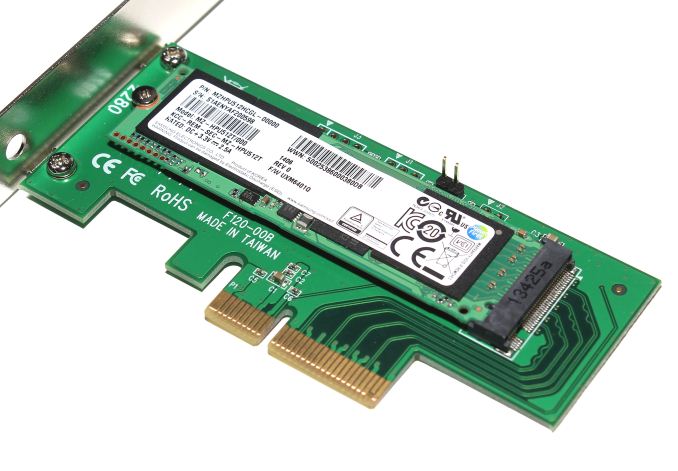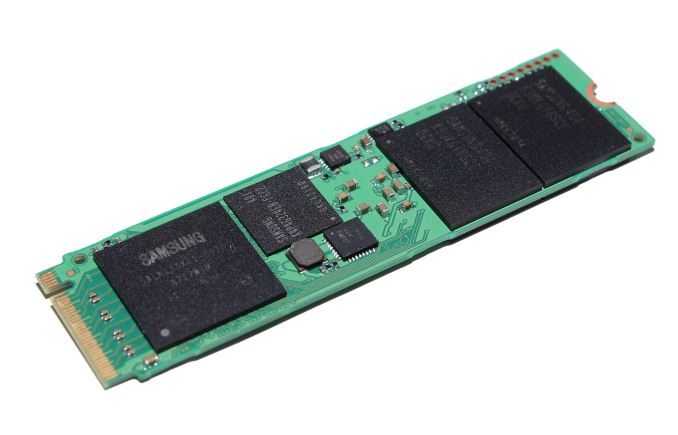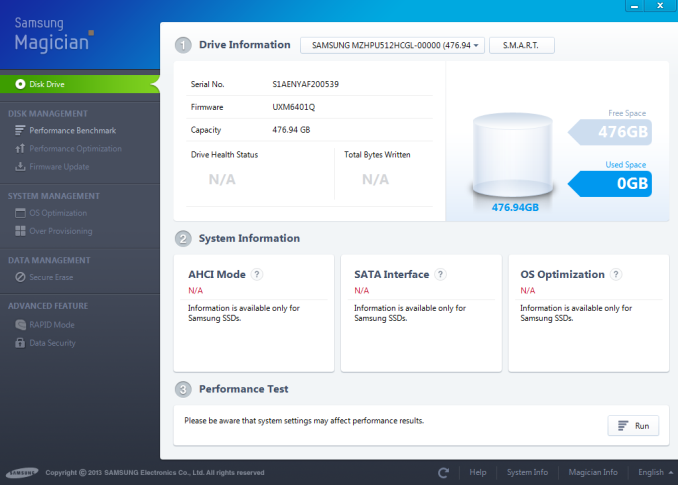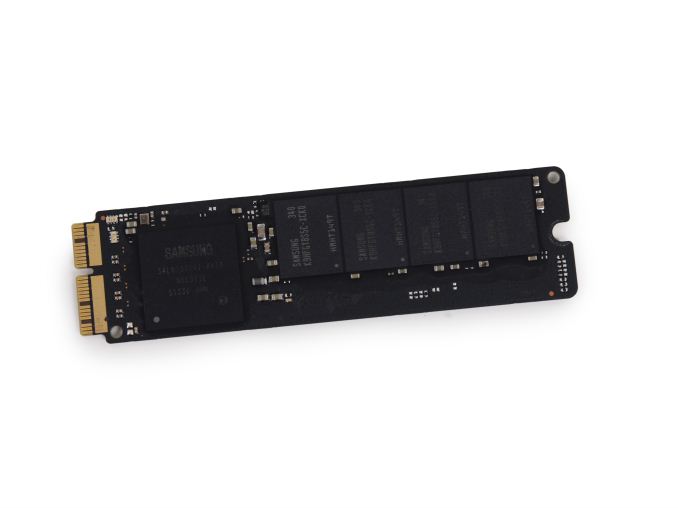Samsung SSD XP941 Review: The PCIe Era Is Here
by Kristian Vättö on May 15, 2014 12:00 PM ESTThe Samsung XP941
In June last year, Samsung made an announcement that they were mass producing the industry's first native PCIe SSD: the XP941. In the enterprise world, native PCIe SSDs were nothing new but in the consumer market all PCIe SSDs had previously just used several SATA SSDs behind a PCIe bridge. Samsung didn't reveal many details about the XP941 and all we knew was that it was capable of speeds up to 1,400MB/s and would be available in capacities of 128GB, 256GB and 512GB. Given that the XP941 was (and still is) an OEM-only product, that wasn't surprising. OEM clients often don't want the components they are buying to be put under a public microscope as it may lead to confusion among their customers (e.g. why isn't the drive in my laptop performing as well as the drive in the review?).
Photography by Juha Kokkonen
The XP941 is available only in M.2 2280 form factor. The four-digit code refers to the size of the drive in millimeters and 2280 is currently the second largest size according to the M.2 standard. Basically, the first two digits refer to the width, which per M.2 standard is always 22mm (hence the 22 in the code) and the last two digits describe the length, which in this case is 80mm. There are four possible lengths in the M.2 spec: 42mm, 60mm, 80mm and 110mm, and the purpose of different lengths is to allow manufacturers to design drives for multiple uses.
The reason for the variable size comes from mSATA, where the issue industry had problems with the fixed size. That's why Apple, ASUS, and others went with custom designs in order to fit more NAND packages on the PCB. I believe 80mm (i.e. 2280) will be the most popular form factor as it's capable of holding up to eight NAND packages but especially drives that are aimed for tablets and other ultra mobile devices may utilize the smaller 2242 and 2260 form factors.
As the XP941 isn't available in retail, Samsung isn't sampling it to media. Fortunately an Australian Samsung OEM retailer, RamCity, was kind enough to send us a review sample. The SSD we received is the highest capacity 512GB model, so we should be able to reach the maximum potential performance. RamCity actually sent us two 512GB drives and I couldn't resist putting the two in RAID 0 configuration in order to see what kind of throughput two drives could offer.
RamCity also sent us a PCIe 3.0 x4 adapter for connecting the drive to our testbed. The adapter in question is a Lycom DT-120, which retails for around $25. There are also other adapters in the market, such as Bplus' dual PCIe 2.0 x4 adapter, but the Lycom is the cheapest I've seen and is likely the best option for the average buyer.
| Samsung SSD XP941 Specifications | |||
| Capacity | 128GB | 256GB | 512GB |
| Controller | Samsung S4LNO53X01 (PCIe 2.0 x4) | ||
| NAND | Samsung 19nm MLC | ||
| Sequential Read | 1000MB/s | 1080MB/s | 1170MB/s |
| Sequential Write | 450MB/s | 800MB/s | 950MB/s |
| 4KB Random Read | 110K IOPS | 120K IOPS | 122K IOPS |
| 4KB Random Write | 40K IOPS | 60K IOPS | 72K IOPS |
| Power (idle / active) | 0.08W / 5.8W | ||
| Warranty | Three years (from RamCity) | ||
The XP941 is based on Samsung's in-house PCIe controller. Samsung isn't willing to disclose any exact details of the controller but I would expect it to be quite similar to the MEX controller found in the 840 EVO, except it utilizes a PCIe interface instead of SATA. The controller supports up to four PCIe 2.0 lanes, so in practice it should be good for up to ~1560MB/s without playing with the PCIe clock settings (it's possible to overclock the PCIe interface for even higher bandwidths). In terms of the software interface, the XP941 is still AHCI based but Samsung does have an NVMe based SSD for the enterprise market. I would say that AHCI is a better solution for the consumer market because the state of NVMe drivers is still a bit of a question and the gains of NVMe are much more significant in the enterprise space (see here why NVMe matters).
NAND wise the XP941 uses Samsung's own 64Gbit 19nm Toggle-Mode 2.0 MLC NAND. There are only four packages on the PCB, two on each side, which means we are dealing with 16-die packages. I'm not sure if Samsung has a proprietary technology for NAND die stacking but at least they seem to be the only manufacturer that is packing more than eight dies in a single package. From what I have heard, other manufacturers don't want to go above eight dies for signal integrity reasons, which directly impacts performance, but Samsung doesn't seem to have issues with this.
Again, no details such as the P/E cycle count are known but I'm guessing the NAND is still rated at the same 3,000 P/E cycles as its 21nm counterpart. Samsung's datasheet doesn't list any specific endurance for the drive, though that makes sense since it's an OEM drive and the warranty will be provided for the whole product (e.g. a laptop) where the drive is used in.
The XP941 shows up in Samsung's Magician software but it's not recognized as a Samsung SSD. This has been typical for Samsung's OEM SSDs as even though they sometimes share the same hardware and firmware as their retail counterparts, the Magician functionality is disabled. It makes sense because PC OEMs often source their drives from more than one SSD OEM, so it wouldn't be fair to buyers if one drive had additional functionality while the other didn't.
The SSD in 2013 Mac Pro - courtesy of iFixit
The XP941 is hardware wise the same drive that you can find inside 2013 Macs, although most of the laptop version are limited to PCIe 2.0 x2 interface. However, the form factor and interface Apple uses are custom and the larger form factor allows for eight NAND packages and thus support for a 1TB model.
Test System
| CPU |
Intel Core i5-2500K running at 3.3GHz (Turbo and EIST enabled) |
| Motherboard | AsRock Z68 Pro3 |
| Chipset | Intel Z68 |
| Chipset Drivers | Intel 9.1.1.1015 + Intel RST 10.2 |
| Memory | G.Skill RipjawsX DDR3-1600 4 x 8GB (9-9-9-24) |
| Video Card |
Palit GeForce GTX 770 JetStream 2GB GDDR5 (1150MHz core clock; 3505MHz GDDR5 effective) |
| Video Drivers | NVIDIA GeForce 332.21 WHQL |
| Desktop Resolution | 1920 x 1080 |
| OS | Windows 7 x64 |
Thanks to G.Skill for the RipjawsX 32GB DDR3 DRAM kit














110 Comments
View All Comments
hulu - Thursday, May 15, 2014 - link
Second page of review, fourth paragraph, states they were only able to aquire the 512 GB version, since as an OEM product Samsung isn't sampling the drive to media.Always helps if you read the entire story before commenting!
JoyTech - Friday, May 16, 2014 - link
In that case, the reviewer better leave out the 128 & 256 GB out or mention the exclusions on first page, not 2nd page, 4th para; a good reviewer should make it easy for readers to access info, not act as lawyers and read the fine print!Also, I forgot to mention that their SSD bench marks have same problem (http://anandtech.com/bench/SSD/730), where they leave out Samsung SSD 840 EVO 250 GB, which is perhaps the best selling SSD in the market now. Very few people give a crap about 1 TB products, which is so proudly displayed in the bench!
Kristian Vättö - Saturday, May 17, 2014 - link
The first page is just an introduction with no mention of the XP941 anyway. It wouldn't have fit the context there and in the end I at least like to think that the reader reads the whole review and not just a paragraph or two. It's rather hard to write something for a reader who reads a part here and part there.As for the 250GB 840 EVO, it is in the bench but we haven't run Storage Bench 2013 on it. That's because the test itself takes around 24 hours to complete and with the strict review times we don't usually have the time to test all available capacities.
critical_ - Thursday, May 15, 2014 - link
Paradoxically, my problem with the M.2 form-factor is the number of sizes available to manufacturers. My Dell Venue 11 Pro tablet has a 2260 size 256GB SSD by Lite-On. There have been lots of firmware issues. The best thing would be to swap it out with a Samsung or Intel variant. However, there isn't much selection out there and 2260 is an oddball size. I'd like a 1TB mSATA SSD but it doesn't exist.Lenovo was smarter in this regard. Their Yoga 2 Pro uses the newer connector for the wireless card but the SSD is plain old mSATA. This allows me to pick from a variety of options without size concerns.
I know I'm ranting and it is still early in the M.2 game but I hope manufacturers settle on providing high capcities in the 2242 and 2260 sizes with plates (like half mPCI-E to full mPCI-E) to allow them to fit in bigger slots.
Babar Javied - Thursday, May 15, 2014 - link
Getting a smaller drive to fit into the bigger slot is easy. As you said, this can/should be easy with the use of "plates" or "expansion cards". So give it some time and you should have lots of options for your device. Should the 2260 size still remain an oddball, you can always get a 2242 size with extensions to help it fit into the bigger slotsdstarr3 - Thursday, May 15, 2014 - link
All due respect to the awesome performance the new interface promises, I still feel like it's going to be a while before the 6Gbps bottleneck makes my computer feel frustratingly slow.darwinosx - Thursday, May 15, 2014 - link
Read the benchmarks or ask someone who has been using PCIE SSD on a Mac for some time now. It's much faster and noticeable.Calista - Friday, May 16, 2014 - link
But also highly depending on what you're doing. Maybe most people are accepting a slight drop in performance in exchange for less issues with compatibility and the option of moving the drive to a second machine down the line or mounting it in a usb cabinet.Sabresiberian - Thursday, May 15, 2014 - link
I have 2 issues with PCIe as a storage interface, at this point in time.First is that, for me, as a high-end gaming PC user, the number of PCIe lanes to the CPU is already limited. SATA lanes are not since I simply don't use that many storage devices. The second is cost. A few weeks ago I bought 2 480GB Sandisk Extreme II's for $300 each, and just saw them for $260 each listed on Newegg - so, for less than the cost of a 512GB XP941 I can get around twice the storage at similar speeds if I install using RAID 0 using current high-end SSD devices.
Until Intel and/or AMD decides to provide more direct PCIe lanes and the cost comes down, PCIe SSDs are just an interesting upcoming technology, for me. :)
SirKnobsworth - Thursday, May 15, 2014 - link
At least on an Intel platform, you wouldn't normally be using lanes from the CPU for a storage device (which are usually dedicated to graphics) - you'd be using lanes from the chipset (of which there are usually 8).